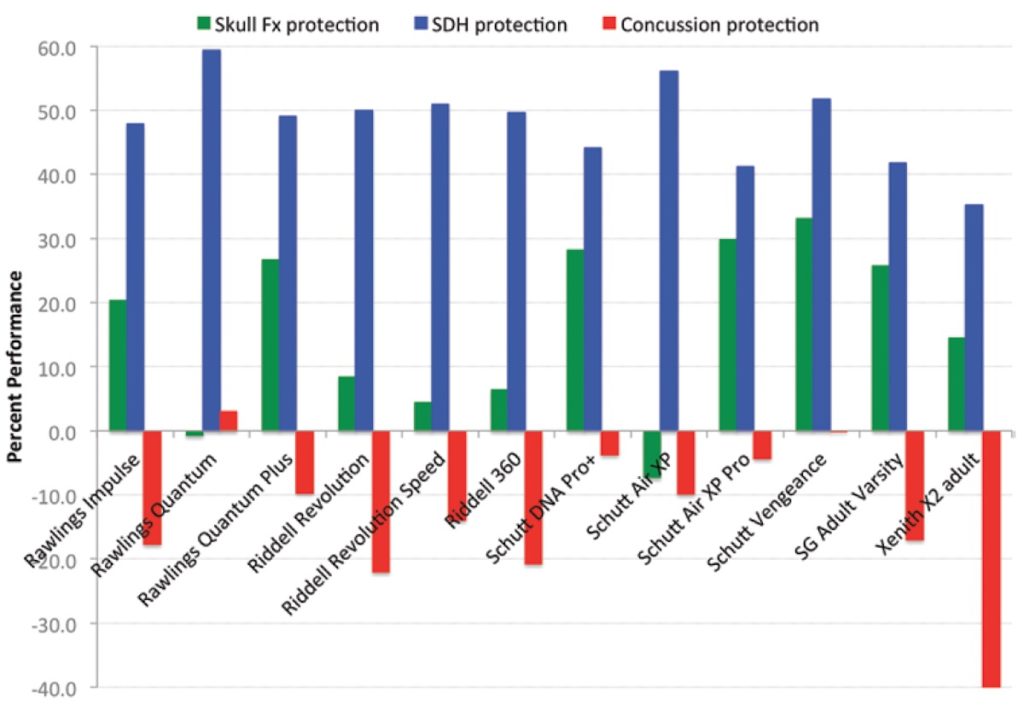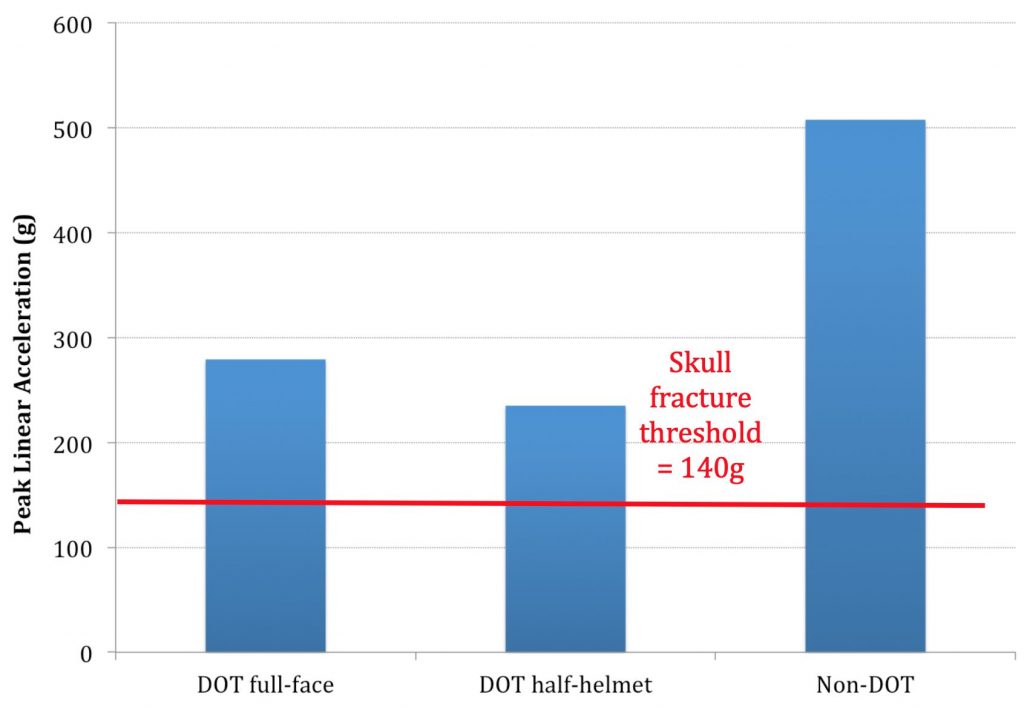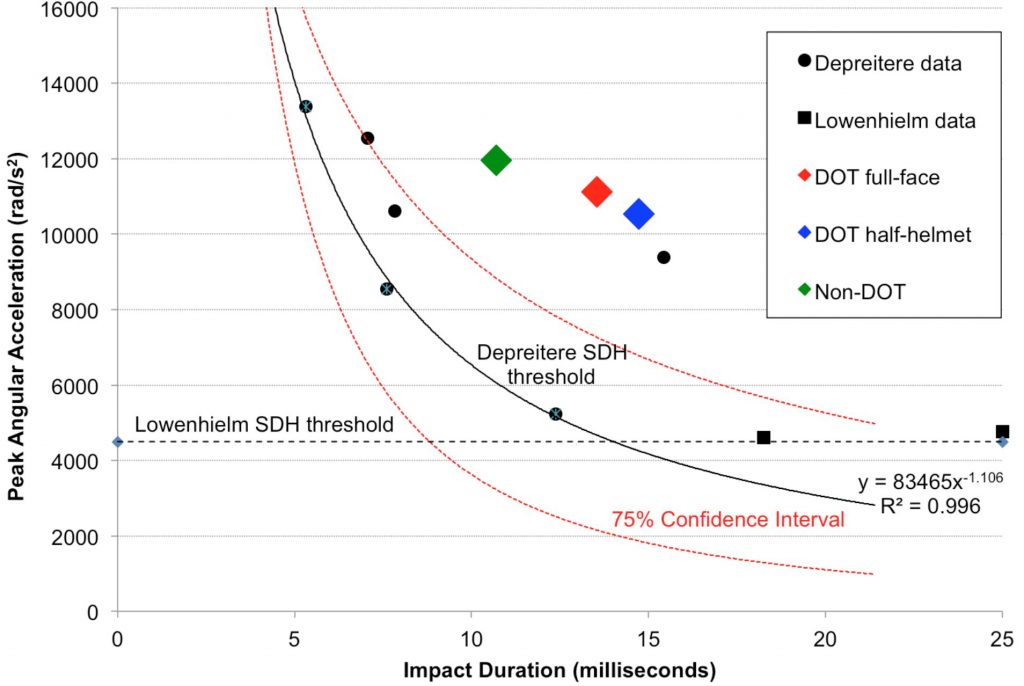Category Archives: helmet expert
Brain Injury in Sports
Dr. Lloyd’s research article “Brain Injury in Sports”, co-authored with Dr. Frank Conidi has been published in the Journal of Neurosurgery.
Please email me at DrJohnLloyd@Tampabay.RR.com if you would like to receive a full copy of the published article.
Abstract
BACKGROUND
Helmets are used for sports, military, and transportation to protect against impact forces and associated injuries. The common belief among end users is that the helmet protects the whole head, including the brain. However, current consensus among biomechanists and sports neurologists indicates that helmets do not provide significant protection against concussion and brain injuries. In this paper the authors present existing scientific evidence on the mechanisms underlying traumatic head and brain injuries, along with a biomechanical evaluation of 21 current and retired football helmets.
METHODS
The National Operating Committee on Standards for Athletic Equipment (NOCSAE) standard test apparatus was modified and validated for impact testing of protective headwear to include the measurement of both linear and angular kinematics. From a drop height of 2.0 m onto a flat steel anvil, each football helmet was impacted 5 times in the occipital area.
RESULTS
Skull fracture risk was determined for each of the current varsity football helmets by calculating the percentage reduction in linear acceleration relative to a 140-g skull fracture threshold. Risk of subdural hematoma was determined by calculating the percentage reduction in angular acceleration relative to the bridging vein failure threshold, computed as a function of impact duration. Ranking the helmets according to their performance under these criteria, the authors determined that the Schutt Vengeance performed the best overall.
CONCLUSIONS
The study findings demonstrated that not all football helmets provide equal or adequate protection against either focal head injuries or traumatic brain injuries. In fact, some of the most popular helmets on the field ranked among the worst. While protection is improving, none of the current or retired varsity football helmets can provide absolute protection against brain injuries, including concussions and subdural hematomas. To maximize protection against head and brain injuries for football players of all ages, the authors propose thresholds for all sports helmets based on a peak linear acceleration no greater than 90 g and a peak angular acceleration not exceeding 1700 rad/sec2.
Please call Dr. Lloyd at 813-624-8986 or email DrJohnLloyd@Tampabay.RR.com if you would like to receive a full copy of the published article “Brain Injury in Sports”
Left Turn Across Motorcycle Path
In 2016 there were more than 8.4 million motorcycles registered in the United States, representing 3.2% of all US vehicles. California, Florida and Texas were the leading States in terms of the motorcycle popularity; collectively representing 22% of all US registered motorcycles. According to the U.S. National Highway Traffic Safety Administration (NHTSA), when compared per vehicle mile traveled with automobiles, due to their vulnerability, motorcyclists’ risk of a fatal crash is 30-35 times greater than that of a car occupant.
Number One Cause of Motorcycle Crashes
Seventy-five percent of accidents were found to involve a motorcycle and a passenger vehicle, while the remaining 25% of accidents were single motorcycle accidents.
The number one cause of motorcycle crashes is a motorist making a left turn across motorcycle path. With reference to the Hurt report in the United States and the MAIDS in-depth investigation of motorcycle accidents in Europe, approximately two-thirds of all motorcycle crashes involving other vehicles are caused due to violation of the motorcycle rider’s right of way by the failure of motorists to detect and recognize motorcycles on the road.
While the motorcycle rider has right of way, they are also more vulnerable to injury. Motorcyclists must therefore be extra-vigilant, especially when approaching intersections. Appropriate riding gear, including a DOT certified helmet, motorcycle jacket and riding boots offer the motorcyclist the best protection. Findings of the Hurt study indicate that severity of motorcyclist injury increases with speed, alcohol consumption, motorcycle size and speed.
Motorcyclist Conspicuity
Conspicuity is one of the key factors in motorcycle road crashes around the world. The inability and difficulty of other road users in detecting motorcycles either at day or at night has contributed to conspicuity related motorcycle crashes. Additional lights and brightly colored riding gear can help to improve motorcyclists conspicuity to other roadway users. The following image depicts this author wearing a hi-visibility motorcycle jacket and helmet to enhance conspicuity.

Please call Dr. Lloyd at 813-624-8986 or email DrJohnLloyd@Tampabay.RR.com to discuss how he can be of help to you with your case.
Motorcycle Helmets Provide Inadequate Protection Against Traumatic Brain Injury
Dr. John Lloyd recently conducted a biomechanical study to evaluate motorcycle helmets in terms of their ability to provide protection against traumatic head and brain injuries. Motorcycle helmet testing proves inadequate protection against concussion and diffuse traumatic brain injuries associated.
Motorcycle accident victims account for more than 340,000 fatalities annually, with the United States ranking 8th highest worldwide in the number of motorcycle accident deaths. 75% of all fatal motorcycle accidents involve brain injury, with rotational forces acting on the brain the primary cause of mortality. Current motorcycle helmets are effective at reducing head injuries associated with blunt impact. However, the mechanism of diffuse traumatic brain injury is biomechanically very different.
Samples of 9 motorcycle helmet models, representing full-face, three-quarter and shorty designs were evaluated. Helmets, fitted to an instrumented Hybrid III head and neck, were dropped at 13 mph in accordance with DOT motorcycle helmet testing standards.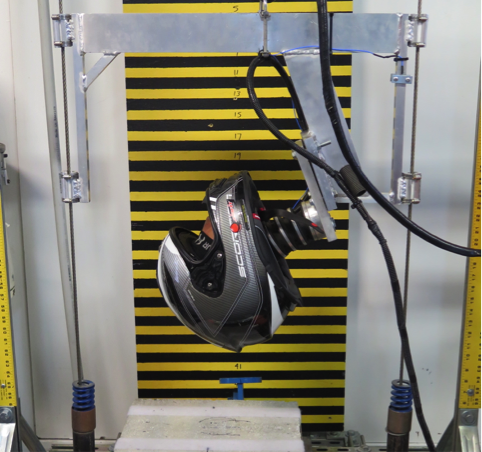
Results show that, on average, there is a 67% risk of concussion and a 10% probability of severe or fatal brain injury associated with a relatively minor 13mph helmeted head impact.
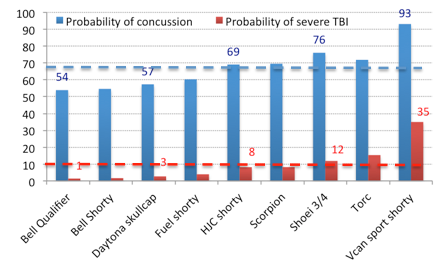
In conclusion, motorcycle helmets provide inadequate protection against concussion and diffuse traumatic brain injuries associated with even relatively moderate impact.
Motorcycle Helmet Standards
Motorcycle helmets were originally developed in the early 20th century and, like most helmets, are modeled after military helmets, the purpose of which is to protect against penetrating head injury. The modern motorcycle helmet, with a hard outer shell and rigid expanded polystyrene (EPS) liner was actually introduced over 60 years ago. The outer shell serves as a second skull, dispersing the impact force over a wider surface area, while the inner shell compresses in an attempt to reduce translational forces. A mechanism to mitigate tangential forces is absent. Since the liner fills the entire inner surface of the shell, tangential forces cannot be absorbed and are transmitted directly to the head and brain. Motorcycle helmet standards focus on reducing the effect of linear impact forces by dropping them from a given height onto an anvil and measuring the resultant peak linear acceleration.
Motorcycle Helmet Standards
In motorcycle helmet testing, the risk of impact loading injuries, such as skull fractures, can be determined by measuring linear accelerations experienced by a surrogate head form in response to impact. Whereas risk of impulse or inertial loading injuries, such as concussion, axonal injury and subdural hematoma can be quantified by measuring impact-related angular accelerations at the center of mass of a test head form.
Unfortunately, the evolution of motorcycle helmet design is not driven by advances in scientific knowledge, but rather by the need to meet applicable testing standards. In the United States, standards include the federal motor vehicle safety standard (FMVSS) #218, commonly known as the DOT motorcycle helmet testing standards, and Snell M2015, while ECE 22.05 and BSI 6658 were adopted in European countries. Test procedures involve dropping a helmeted head form onto various steel anvils at impact velocities ranging from only 5.0 to 7.75 m/s (11-17 mph). Pass/fail is based on the ability of the helmet to provide protection against forces associated with linear acceleration in response to impact.
 Current motorcycle helmet testing standards do not incorporate measures of angular acceleration and therefore fail to assess whether helmets offer protection against catastrophic brain injuries. The omission of this critical measure is reflected epidemiologically in the disproportion of closed head injuries in fatal motorcycle accidents.
Current motorcycle helmet testing standards do not incorporate measures of angular acceleration and therefore fail to assess whether helmets offer protection against catastrophic brain injuries. The omission of this critical measure is reflected epidemiologically in the disproportion of closed head injuries in fatal motorcycle accidents.
Motorcycle Accidents and Brain Injury
To consider whether a motorcycle helmet might reduce the risk of brain trauma in a motorcycle accident it is first important to understand the two primary mechanisms associated with traumatic brain injury – impact loading and impulse loading, according to motorcycle helmet expert, Dr. John Lloyd.
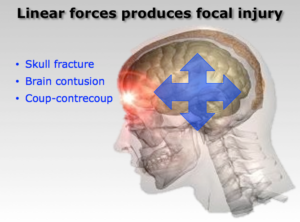 Impact loading involves a direct blow transmitted primarily through the center of mass of the head, resulting in extracranial focal injuries, such as contusions, lacerations and external hematomas, as well as skull fractures. Shock waves from blunt force trauma may also cause underlying focal brain injuries, such as cerebral contusions, subarachnoid hematomas and intracerebral hemorrhages.
Impact loading involves a direct blow transmitted primarily through the center of mass of the head, resulting in extracranial focal injuries, such as contusions, lacerations and external hematomas, as well as skull fractures. Shock waves from blunt force trauma may also cause underlying focal brain injuries, such as cerebral contusions, subarachnoid hematomas and intracerebral hemorrhages.

Whereas, impulse or inertial loading caused by sudden movement of the brain relative to the skull, produces cerebral concussion. Inertial loading at the surface of the brain can cause subdural hemorrhage due to bridging vein rupture, whereas if affecting the neural structures deeper within the brain can produce diffuse axonal injury (DAI).
Epidemiology Studies
Two major epidemiologic studies into the causation of motorcycle accidents have been conducted in North America and Europe: the Hurt Report and the MAIDS report. The Hurt Report showed that failure of motorists to detect and recognize motorcycles in traffic is the predominating cause of motorcycle accidents. Seventy-five percent of accidents were found to involve a motorcycle and a passenger vehicle, while the remaining 25% of accidents were single motorcycle accidents. Two-thirds of motorcycle-car crashes occurred when the car driver failed to see the approaching motorcycle and violated the rider’s right-of-way. Findings indicate that severity of injury increases with speed, alcohol motorcycle size and speed.
The MAIDS study (Motorcycle Accidents In Depth Study) is the most recent epidemiologic study of accidents involving motorcycles, scooters and mopeds, which was conducted in 1999 to investigate motorcycle accident exposure data across five European countries. Key findings show that passenger cars were the most frequent collision partner (60%), where 69% of the drivers report that they did not see the motorcycle and the predominance of motorcycle accidents (54.3%) occurred at an intersection.
In 1995, the European Commission Directorate General for Energy and Transport initiated a Cooperative Scientific and Technical Research (COST) program to investigate Motorcycle Safety Helmets. Several agencies from Finland, the United Kingdom, France and Germany participated in this study, which compiled and analyzed data from 4,700 motorcycle fatalities in Europe, each year. The COST report documents that 75% of all fatal motorcycle accidents involve head injury. Linear forces were present in only 31% of fatal head injuries, while rotational forces were found to be the primary cause in over 60% of cases. Within the scope of this study experiments were performed using drop tests with accelerometers to measure linear and rotational accelerations of the brain and skull mass associated with different types of impacts. These tests confirmed rotational acceleration to be a primary cause of brain injury in helmeted motorcycle accidents.
While the motorcycle helmet is currently the most effective means of protection for riders, data suggests that motorcycle helmets are only 37-42% effective in preventing fatal injury. By reducing the effects of blunt trauma to the head it is generally believed that risk of brain injury, including concussion, axonal injury and hematoma would also be reduced. However, the mechanisms of head and brain injury are very different. New research shows that these mechanisms are poorly coupled, contrary to previous beliefs.
Summary
- Motorcycle helmet expert report that rotational forces acting on the brain are the underlying cause of traumatic brain injuries.
- Motorcycle helmets, including those certified under DOT and SNELL standards are designed to mitigate forces associated with linear acceleration.
- According to motorcycle helmet expert, helmets are not currently certified under either DOT or SNELL standard against their ability to protect against the angular / rotational forces.
- Epidemiologic evidence from the COST-327 report indicates that motorcycle helmets do not provide adequate protection against closed head and brain injuries
New Research
Motorcycle helmet expert Dr. John Lloyd recently published a new study: Biomechanics of Motorcycle Helmets: Protection Against Head and Brain Injury. Testing proves that motorcycle helmets provide inadequate protection against concussion and severe traumatic brain injury associated with even relatively minor head impact
Helmets Do Not Prevent Brain Injury
Helmets are intended to minimize blunt force trauma to the head, such as skull fracture, lacerations and contusions. Whereas risk of diffuse brain injuries, such as concussion, brain bleeding and axonal injuries are caused when brain tissue, nerves and blood vessels stretch and tear as the head moves suddenly but the brain lags behind. The type of brain injury is dependent on the magnitude of this strain and the time duration over which it acts on the brain.
Risk of focal head and brain injury is measured in terms of peak linear acceleration associated with impact, while risk of diffuse brain injury is measurable in terms of peak angular acceleration.
While helmets can prevent fatalities associated with penetrating head trauma, it may be argued that protection against diffuse brain injury is of paramount importance. After all, cuts, bruises and even bone fractures will heal, but brain injuries often have life long neurologically devastating effects.
Unfortunately, helmet testing standards addresses only the risk of blunt force trauma, not risk of brain injury.
Helmets may reduce the rotational forces acting on the brain. But since helmets are not currently certified according to their ability to protect against brain injury the level of protection is not standardized. Hence, it is possible to sustain catastrophic diffuse brain injuries, even while wearing a helmet.
As a biomechanics researcher, Dr. John Lloyd has dedicated his career to understanding the biomechanics of brain injuries. One objective of which is to develop a new generation of helmets for sports and motorcycling using “intelligent” materials that hold great promise for reducing the risk of traumatic brain injuries.
Dr. Lloyd’s biomechanics laboratory employs a specialized helmet testing apparatus for evaluating the risk of both head and brain injuries. This apparatus has been published in a peer-reviewer journal.
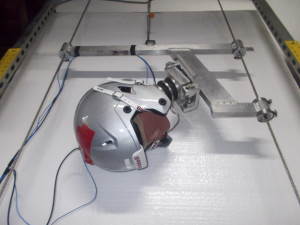 Using this apparatus, Dr. Lloyd, evaluates the linear and rotational forces associated with specific impact events, such as a motorcycle crash or sports injury, to determine whether an unhelmeted condition, or the type of helmet might have prevented the injury sustained. This apparatus has also been used to investigate whether a particular helmet failed to perform or did not meet scientifically-acceptable levels of protection.
Using this apparatus, Dr. Lloyd, evaluates the linear and rotational forces associated with specific impact events, such as a motorcycle crash or sports injury, to determine whether an unhelmeted condition, or the type of helmet might have prevented the injury sustained. This apparatus has also been used to investigate whether a particular helmet failed to perform or did not meet scientifically-acceptable levels of protection.
Traditional testing of motorcycle helmets focuses on reducing the effect of linear impact forces by dropping them from a given height onto an anvil and measuring the resultant peak linear acceleration. According to the Federal Motor Vehicle Safety Standard (FMVSS) 218, commonly known as the DOT helmet standard, the test involves dropping a motorcycle helmet onto a flat steel and hemispherical anvil at an impact velocity of 6.0 m/s (13.4 mph). In general, if the resultant peak linear acceleration is less than 400G, the helmet is considered acceptable. Current motorcycle helmet testing standards do not incorporate measures of angular acceleration and therefore do not address whether any motorcycle helmet can provide protection against diffuse brain injuries, including concussion.
In 1995, the European Commission Directorate General for Energy and Transport initiated a Cooperative Scientific and Technical Research (COST) program to investigate Motorcycle Safety Helmets. Several agencies from Finland, the United Kingdom, France and Germany participated in this study, which compiled and analyzed data from 4,700 motorcycle fatalities in Europe, each year. The COST report [i] documents that 75% of all fatal motorcycle accidents involve head injury. Linear forces were present in only 31% of fatal head injuries, while rotational forces were found to be the primary cause in over 60% of cases.
Dr. Lloyd recently conducted independent testing of various motorcycle helmets utilizing a methodology that has been peer-reviewed [i] and has survived a Daubert motion for exclusion [ii]. The following figure presents peak angular acceleration results of repeated testing of various motorcycle helmets, including: (i) Voss novelty helmet, (ii) Bell shorty helmet, (iii) Daytona shorty helmet, and (iv) Bell full-face helmet, compared with an unhelmeted condition for impacts onto concrete at approximately 20mph. The red horizontal line on the figure indicates the 50% threshold for concussive trauma, as defined by Pellman et al [iii].
Results show that while a novelty or DOT approved motorcycle helmet will reduce the peak angular acceleration associated with a head impact relative to an unhelmeted condition, the level of protection is not sufficient to prevent diffuse brain injury in a typical motorcycle accident.
[i] Caccese V, Ferguson J, Lloyd J, Edgecomb M, Seidi M and Hajiaghamemar M: Response of an Impact Test Apparatus for Fall Protective Headgear Testing Using a Hybrid-III Head/Neck Assembly. Experimental Techniques, 2014.
[ii] Superior Court, Judicial District of Hartford, CT. Docket Number: HHD-CV-13-6043998-S. Case Caption: SHUMBO, JAKE Et Al v. K2 SPORTS USA Et Al. Order #227.86 regarding: 03/02/2015 Motion to Exclude Expert Testimony. Notice Issued: 07/09/2015
[iii] Pellman EJ, Viano DC, Tucker AM, Casson IR, Waeckerle JF: Concussion in professional football: reconstruction of game impacts and injuries. Neurosurgery 53(4): 799-812, 2003
[iv] COST-327 report of the European Commission Directorate General for Energy and Transport on Motorcycle Safety Helmets. (1999).
Helmets – The Ultimate Protection?
 The common belief among riders is that a motorcycle helmet protects the whole head, including the brain. However testing standards in Europe (ECE 22.05) and the US (DOT & Snell), which involve dropping helmeted headforms from heights of 2-3 meters onto a steel plate, only evaluate a motorcycle helmet in terms of its ability to protect against blunt force trauma, such as skull fractures and penetrating head injuries. The mechanism underlying diffuse brain injuries, such as concussions and brain hemorrhages is distinctly different, but is not assessed by current motorcycle helmet testing standards.
The common belief among riders is that a motorcycle helmet protects the whole head, including the brain. However testing standards in Europe (ECE 22.05) and the US (DOT & Snell), which involve dropping helmeted headforms from heights of 2-3 meters onto a steel plate, only evaluate a motorcycle helmet in terms of its ability to protect against blunt force trauma, such as skull fractures and penetrating head injuries. The mechanism underlying diffuse brain injuries, such as concussions and brain hemorrhages is distinctly different, but is not assessed by current motorcycle helmet testing standards.
Imagine a bowl of jelly, where the bowl represents the skull and the jelly represents the brain. The bowl (skull) serves to protect the jelly (brain) from impact by dispersing forces over a larger surface area. If the bowl were impacted such that the force passes through the center of the jelly, the jelly moves very little. This is called linear force. Whereas, if you rotate the bowl of jelly between your hands you will see that the jelly moves quite a lot, especially towards its center. This is called a rotational force.
In reality, most motorcycle helmet impacts will produce both linear and rotational forces. In the case of head and brain injury, linear forces are responsible for injuries such as bruises and fractures. Whereas rotational forces cause the nerves and blood vessels in the brain to stretch and tear, leading to concussions, injury to the nerve fibers (axonal trauma) and brain bleeding (hematomas).
The human head is designed to protect the brain against typical impacts associated with daily living, such as normal bumps and falls. The skull can be thought of as a helmet to the brain by resisting penetrating injury to the brain. While the scalp glides over the skull to decrease rotational forces, thereby reducing the risk and severity of diffuse brain injuries. However, the forces associated with motorcycle collisions far exceed that which the human skull and scalp was intended to protect. Hence in motorcycling the use of a helmet to reduce the risk of such injuries is typically mandated.
Helmets are designed with 3 principal components – the outer shell, the inner liner and a comfort layer. The shell is typically made of polycarbonate plastics or fiberglass and serves two purposes; to minimize the likelihood that a sharp object might penetrate the head, and to dissipate the impact over a larger surface area. The inner liner is made from EPS foam (polystyrene) and serves to absorb the impact forces. The comfort layer does nothing more than provide comfort between the head and the polystyrene liner. Unfortunately, the polystyrene liner has limited effectiveness at reducing the rotational forces – those responsible for diffuse brain injuries – below safe levels.
A cooperative study was undertaken in Europe in the late 1990s to examine motorcycle accidents and their causes. Based on data from 4,700 helmeted motorcyclist deaths, the study found head injuries accounted for three-quarters of all fatalities. More than 60 percent of which were brain injuries caused by rotational forces, while only 30 percent of fatal head injuries were due to linear forces. This extensive study proves that motorcycle helmets are inadequate in providing necessary protection against diffuse brain injuries.
One might propose that protection against diffuse brain injury ought to deserve a higher priority. After all, the skull will likely heal from trauma, but the brain may not.
The challenge with protective headgear, including motorcycle, military and sports helmets is that, due to the characteristics of the liner materials, the head is directly coupled to the helmet. That is, the head and helmet are effectively joined and move as one. Therefore upon impact, any rotational forces generated on the helmet are transmitted directly to the brain. In fact, due to the size of helmets rotational forces can actually be amplified. The solution lies in de-coupling the head from the helmet, much the way that the scalp is de-coupled from the skull, so that the helmet can have some degree of rotation independent of the head. In this way, the rotational forces are dampened before they are transmitted to the brain, thereby lessening the risk and severity of brain injury.
BRAINS, Inc., of which Dr. Lloyd is the Research Director, is developing a new generation of motorcycle helmets, utilizing a patented composite of shear-thickening non-Newtonian materials. Due to their nature, these advanced materials respond differently to linear and rotational forces, thereby allowing the helmet some independent rotational motion, effectively de-coupling the helmet from the head. This technology was demonstrated at NI Week (http://youtu.be/T591x950oRI) and shows great promise for protection against both blunt force trauma and traumatic brain injuries.
Given the choice of a helmet that protected against skull fracture and one which also provides protection against brain injury, which would you choose?
For more information, please contact John@DrBiomechanics.com
Biography:
Dr. John Lloyd holds a PhD in Ergonomics from Loughborough University and is a Brain Injury Specialist. He is an expert in the field of brain injury biomechanics.
As a motorcycle enthusiast, John has clocked more than 250,000 miles and completed numerous training programs. Dr. Lloyd has served as a biomechanics expert on a variety of motorcycle accident cases.
Helmeted Motorcyclist Fatality
Two helmeted motorcyclist were traveling on a rural state road when a tractor-trailer driver failed to see the bikes and made a left turn in front of them to enter a truck stop. The rider in the right track had little time to respond and collided head first into the box trailer. He was pronounced deceased at the scene.

The helmeted motorcyclist was wearing a non-compliant or ‘novelty’ helmet, which did not meet DOT motorcycle helmet standards (FMVSS 218). Opposing counsel claimed that had the biker been wearing a DOT-certified motorcycle helmet he may have survived the impact.
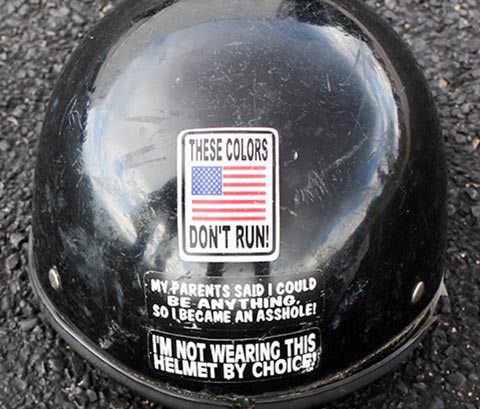
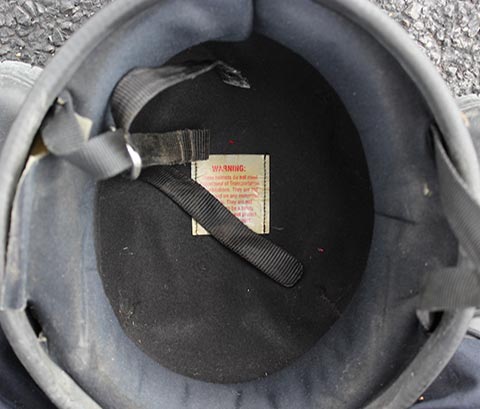
Motorcycle helmet expert, Dr. John Lloyd, was retained to evaluate and compare the protective performance of DOT-certified and novelty motorcycle helmets.
Based on a comprehensive motorcycle accident reconstruction it was determined that the impact speed of the rider was 45 to 50 miles per hour. Motorcycle helmet certification tests typically involve impact speeds of 13-17 miles per hour. Therefore a dedicated apparatus was constructed to generate higher impact speeds. Using a force-balanced twin pendulum apparatus, Dr. Lloyd was able to generate head impact speeds similar to those specific to the subject crash, yet preserve the standard DOT test methodology, thereby avoiding a Daubert challenge.
Eight DOT and non-DOT helmets were purchased for this study. Each was impacted once in the frontal region while fitted to an instrumented crash test dummy head. High speed data and video were acquired for each test.
Results demonstrate that, although the tested DOT-certified motorcycle helmets outperformed the tested novelty helmets, neither would provide adequate protection against head injuries, such as skull fractures, contusions and lacerations, or brain injuries, including hemorrhages or axonal injury in an impact of this magnitude.
Dr. Lloyd’s prior published motorcycle helmet studies demonstrate that while DOT-certified motorcycle helmets can reduce the risk of traumatic head injuries, typical helmets do not afford any protection against acute brain injury.
Why all head protection is in need of a redesign
The humble helmet dates back nearly 3000 years and though it has been used prolifically in warfare, it is now most commonly used to provide head protection outside the combat arena.
However, although applications might have diversified, it is still fundamentally designed and used to provide the same thing.
So when this most traditional of objects is combined with modern sensor technologies, greater test data resolution and analysis, there is bound to be fresh insight.
And this is the case for many conventional designs where sensors, test and measurement technologies are changing conventional thinking into how something has been designed, to how it should be designed.
It sets the scene and means helmet design is on a collision course for further impact protection, specifically in preventing serious brain injury by giving helmet designers greater clarity in to the mechanical forces at play in any particular scenario.
It was this, along with a lifetime of comprehensive knowledge, which enabled biomechanist Dr John Lloyd, research director of BRAINS, to start up a company dedicated to improving current helmet technology and ultimately improve protection for wearers. He aims to shed new light on helmet design, and improve protection against the fundamental causes of concussion and brain injury.
“There are two key forces at play during a head impact,” said Dr Lloyd, speaking at this year’s National Instruments Week in Austin, Texas. “Firstly there are linear forces, these are the ones that cause visible injuries such as bruising and skull fractures. However, the second is the rotational forces. These are the ones that cause invisible injuries such as concussion and brain injury.
“Current helmet testing technologies measure the linear forces. However, at this time, they do not measure the rotational forces, so consequently we have helmets for many sports that do not test against their ability to provide protection against concussions and brain injury.”
Whether it is for riding a bike, horse riding, skiing or indeed for the soldier in the field, the effect of rotational movement is the same. Yet, it is rarely tested for, and even less frequently measured, to see how effective any helmet is in rotation force protection.
Dr Lloyd modified the standard apparatus used for testing helmets (see the rig on page 28), where a head section is raised 2m on a rig and dropped under gravity before it hits a striking plate with an impact force in the region of 4500N. However, instead of using a standard head form, Dr Lloyd replaced it with a standard automotive crash test dummy head and neck section. This way, when the head impacts the striking plate at the bottom of the test rig it will rotate, and the movement measured.
“We had multiple sensors embedded in the centre of mass of this head form,” explained Lloyd. “So, during the impact we were able to measure the linear acceleration as well as the angular motion of the head.
“My measuring apparatus includes sensors from several manufacturers.. The angular rate sensor, for example, that is used to measure the rotational forces is a highly specialised sensor. And, as a result, has its own data acquisition hardware and software.”
Simplifying synchronisation
Trying to integrate all this data from different sensors was a challenge at best. And to make matters more complicated, the peak linear acceleration and peak angular acceleration actually happen at different points in time.
“So while you can just line up the data,” he said, “there is a lag between them. So we need to measure that lag, which is a critical measurement in the research.”
To resolve the problem, Dr Lloyd uses both the National Instruments LabView graphical software and a CompactDAQ to interface with the sensors and provide the necessary synchronisation between the various sensors.
Dr Lloyd modified his apparatus for testing helmets used by American footballers in the National Football League (NFL), to develop understanding of the how spinal and head injuries are caused and improve the design of the standard helmet.
“The results are pretty alarming in terms of how little protection they provide against concussions and traumatic brain injuries,” he said.
“Based on lessons learned from that study, I have developed a new ‘football’ helmet prototype. This uses a patent pending matrix of non-Newtonian materials and when we tested the prototype helmet, on the same apparatus, the result blew me away. Not only did these materials reduce the linear forces but compared to the standard football helmet they actually reduced the rotational forces that cause concussion and brain injury by an amazing 50%.”
The non-Newtonian materials Lloyd has in mind are inexpensive and produce a helmet that is considerably lighter and even said to be more comfortable for those wearing them.
Dr Lloyd is now expanding the concept of reducing rotation forces in helmets in every application and said it can be applied to almost any helmet design to help reduce concussion and brain injuries from sports to leisure and even back to warfare.
Building a rig and conducting the test
A modification to the US National Operating Committee on Standards for Athletic Equipment (NOCSAE) standard test apparatus was used by Dr John Lloyd, research director of US helmet research start-up, BRAINS.
He developed and validated a new helmet test rig to measure the impact of protective headwear to include measurements of both linear and angular kinematics. This apparatus consists of a twin wire fall test system equipped with a drop arm that incorporates a 50th percentile Hybrid III head and neck assembly from HumaneticsATD crash test dummy, as used in the automotive industry.
The aluminium fly arm runs on Teflon sleeves through parallel braided stainless steel wires, which are attached to mounting points in the building structure and anchored into the concrete foundation. The anvil, onto which the head drop systems impacts, consists of a 350mm x 350mm steel based plate.
Both the standard Riddell Revolution Speed US university football helmet, and the prototype BRAINS helmet that incorporates a non-Newtonian matrix, were dropped from a height of 2m onto a flat steel anvil, in accordance with American Society for Testing and Materials (ASTM) standards. This generated an impact velocity of 6.2 m/s (13.9 mph).
Instrumentation:
A triaxial accelerometer from PCB Piezotronics and three DTS-ARS Pro 18k angular rate sensors (Diversified Technical Systems) were affixed to a tri-axial block installed at the centre of mass in the Hybrid III head form. Data from the accelerometer and angular rate sensors were acquired using National Instruments compactDAQ hardware.
Analysis:
Data from the analogue sensors were acquired at 10,000Hz, per channel, using LabView and then filtered in Matlab using a phaseless 4th order Butterworth filter with a cut off frequency of 1650Hz. Angular acceleration values were derived from the angular velocity data based on a 5-point least squares quartic equation.
Result:
The result of the new helmet design shows significant improvement in rotational acceleration exerted on the head and neck, cutting the overall force by nearly 50%.
Author
Justin Cunningham
– See more at: http://www.eurekamagazine.co.uk/design-engineering-features/technology/why-all-head-protection-is-in-need-of-a-redesign/66493/#sthash.6Tv5duXE.dpuf


